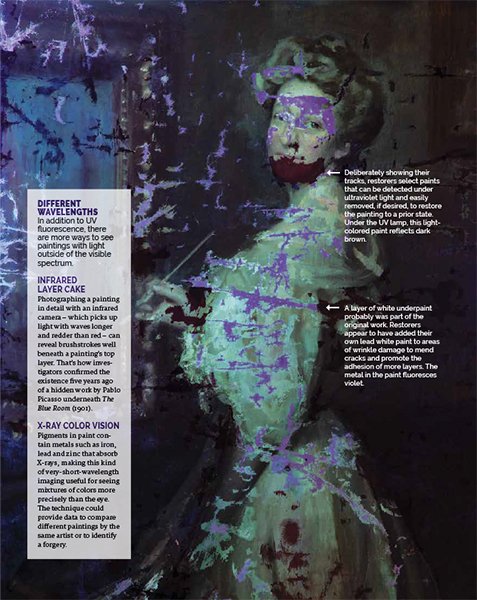New light on art
In a spring chemistry course, undergraduates are learning how to uncover forgeries, predict aging, attribute work to a specific artist, preserve ailing pieces and work with restorations.

Self-portrait of unknown artist, circa 1900, oil on canvas, 42 x 34 inches. The partially restored painting has been photographed under an ultraviolet lamp.
Read complete print version of article »
Making art in studio classes helped Kate Hoffmann to manage her stress as an undergraduate chemistry major.
“It’s actually not that different from chemistry,” she said. “Chemists are really practical people who are standing at a bench and mixing two things together, and it’s a long process. It takes a lot of patience. It takes a lot of meticulous work with steady hands and the right level of caffeine.”
Two years ago, university curator Rachel T. Schmid spoke to faculty members about how to organize an art gallery exhibit tied to a course in any discipline. That led to two innovative collaborations during the current academic year. First, Schmid and Hoffmann, the John Stauffer Professor of Analytical Chemistry at Cal Lutheran, put together the art exhibit Traces. And now, Hoffmann and Robert Dion, an adjunct faculty member, are team-teaching a related spring 2019 course on “Chemical Investigations of Art.”
Students in the hands-on course spend time with objects in the exhibition and with other works of art, learning how to strip varnish off paintings with solvents and where to find chemical information in mosaics and sculptures. They ask questions about paintings and other works of art, considering what tools and techniques are available to answer them.
“Is it truly painted by this person? Has something happened to the painting since? Are we going to lose this painting? Has somebody whitewashed over a mural? Is the wall falling down?” Hoffmann said.
Read full article with annotated painting under ultraviolet light.